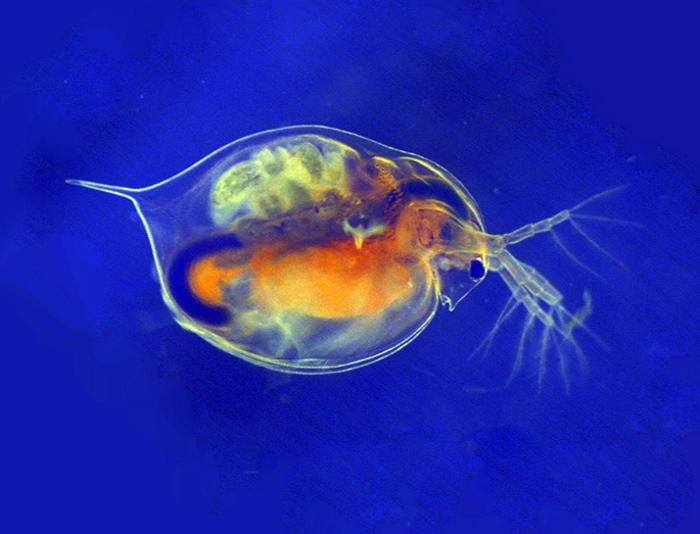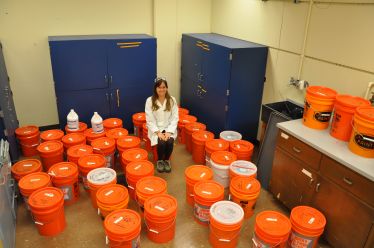It turns out that silver and titanium nanomaterials (e.g. silver nanoparticles washed out of athletic clothing) in wastewater may have ‘negative’ and ‘positive’ effects on freshwater and marine life depending on the species.
A November 18, 2019 news item on Nanowerk provides an introduction to the research (Note: Links have been removed),
You may not always think about it when you do your laundry or flush the toilet; but whatever you eat, wear or apply on your skin ends up in wastewater and eventually reaches the environment. The use of nanoparticles in consumer products like textiles, foods and personal care products is increasing.
What is so special about nanoparticles, is their tiny size: One nanometer is one billionth of a meter. The small size gives nanoparticles unique and novel properties compared to their bigger counterparts and may for example reach locations that bigger particles cannot reach.
Further, pristine nanoparticles behave differently from nanoparticles in the environment. In the environment, nanoparticles are transformed by interacting and forming aggregates with other particles, elements or solids, and thereby obtain other physicochemical properties.The transformation of these tiny particles in wastewater treatment processes and their effect on freshwater and marine organisms, have largely been unknown.
Increased mortality of marine crustaceans.In a study (“Ecotoxicological Effects of Transformed Silver and Titanium Dioxide Nanoparticles in the Effluent from a Lab-Scale Wastewater Treatment System”) conducted at the Norwegian Institute for Water Research (NIVA), Anastasia Georgantzopoulou and colleagues from NIVA and SINTEF investigated how silver and titanium dioxide nanoparticles behave in wastewater treatment plants, and how marine and freshwater organisms are affected by them.

A November 18, 2019 NIVA press release, which originated the news item, fills in the details,
The researchers made a laboratory-scale wastewater treatment plant, using sludge from a wastewater treatment plant in Norway. They added environmentally relevant concentrations of silver (Ag) and titanium dioxide (TiO2) nanoparticles over a 5-week period and used the treated wastewater to assess the effects of transformed nanoparticles on freshwater and marine organisms, as well as on gill cells from rainbow trout.
The experiment demonstrated contrasting effects on the two crustacean species. For the marine copepod (Tisbe battagliai), mortality increased by 20-45%, whereas exposure to ttreated wastewater did not have any adverse effects on the freshwater crustacean (Daphnia magna).
“These differences are probably due, at least partly, to the two species’ different feeding habits, in combination with the fact that the nanoparticles showed a strong association to solids present in the wastewater”, Georgantzopoulou says, and explains:
“Daphnia magna is an organism that filters water for food, whereas the marine copepod feeds on bottom surfaces – like effluent solids that have settled out from the water. The bottom feeding crustacean is therefore more likely to ingest nanoparticles, and thereby be affected by solid-associated nanoparticles”.
Effects on algal species
Nanoparticle-containing treated wastewater also affected algal growth, but the two algae species did not have a common response: The marine algae (Skeletonema pseudocostatum) responded with a 20-40 % growth inhibition, while the algal growth of the freshwater algae (Raphidocelis subcapitata) was actually stimulated, by a 40 % increase, accompanied by increased cell aggregation. The latter is probably some kind of a defense mechanism, aiming to decrease the surface area exposed to toxic particles.
“The results from our study indicate that algal responses to the treated wastewater exposure are species-dependent. This is possibly due to differences in algal cell size, surface area, and cell wall composition”, the NIVA researcher explains.
Increased permeability of fish gill cells
The researchers also found effects of silver and titanium nanoparticles on fish gill cells using an in vitro gill cell line model. As large amounts of water are passing through the gills, and they constitute a barrier to the external environment, this organ is highly exposed to water-borne contaminants, including nanoparticles.
“Exposure to nanoparticle-containing wastewater lead to an increase in reactive oxygen species, a group of molecules that can easily react with and damage cells. This was followed by increased permeability of the gill cells, leading to a compromised barrier function”, Georgantzopoulou says.
“However, the concentrations of silver and titanium nanoparticles in the treated wastewater were too low to fully account for the effects on cell permeability alone. The wastewater effluent is a complex mixture of materials, and the permeability response is probably caused by a combination of the presence of nanoparticles and other stressors”, Georgantzopoulou adds.
Wastewater treatment-transformation of nanoparticles
“We carried out this study on wastewater treatment plant-transformed nanoparticles, and compared them to pristine nanoparticles, as the former is more relevant to what is actually happening in the environment. The increased toxicity of the transformed nanomaterials observed in the study indicates that the effects cannot be predicted by assessing the effects of nanomaterials in their pristine form and highlights the importance of understanding their behavior, environmental transformation and interaction with organisms. Future studies should take nanoparticle transformation into account and focus on a more relevant experimental exposure conditions incorporating transformed nanoparticles in more long-term impact studies to provide a better understanding of their potential impacts”, Georgantzopoulou concludes.
Here’s a link to and a citation for the paper,
Ecotoxicological Effects of Transformed Silver and Titanium Dioxide Nanoparticles in the Effluent from a Lab-Scale Wastewater Treatment System by Anastasia Georgantzopoulou, Patricia Almeida Carvalho, Christian Vogelsang, Mengstab Tilahun, Kuria Ndungu, Andy M. Booth, Kevin V. Thomas, Ailbhe Macken. Environ. Sci. Technol. 2018, 52, 16, 9431-9441 DOI: https://doi.org/10.1021/acs.est.8b01663 Publication Date:July 26, 2018 Copyright © 2018 American Chemical Society
This paper is behind a paywall.
